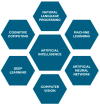Enhancing Thoracic Surgery with AI: A Review of Current Practices and Emerging Trends
- PMID: 39451768
- PMCID: PMC11506543
- DOI: 10.3390/curroncol31100464
Enhancing Thoracic Surgery with AI: A Review of Current Practices and Emerging Trends
Abstract
Artificial intelligence (AI) is increasingly becoming integral to medical practice, potentially enhancing outcomes in thoracic surgery. AI-driven models have shown significant accuracy in diagnosing non-small-cell lung cancer (NSCLC), predicting lymph node metastasis, and aiding in the efficient extraction of electronic medical record (EMR) data. Moreover, AI applications in robotic-assisted thoracic surgery (RATS) and perioperative management reveal the potential to improve surgical precision, patient safety, and overall care efficiency. Despite these advancements, challenges such as data privacy, biases, and ethical concerns remain. This manuscript explores AI applications, particularly machine learning (ML) and natural language processing (NLP), in thoracic surgery, emphasizing their role in diagnosis and perioperative management. It also provides a comprehensive overview of the current state, benefits, and limitations of AI in thoracic surgery, highlighting future directions in the field.
Keywords: AI; RATS; VATS; artificial intelligence; precision medicine; precision surgery; thoracic surgery.
Conflict of interest statement
The authors declare no conflicts of interest.
Figures
Similar articles
-
Revolutionizing surgery: AI and robotics for precision, risk reduction, and innovation.J Robot Surg. 2025 Jan 7;19(1):47. doi: 10.1007/s11701-024-02205-0. J Robot Surg. 2025. PMID: 39776281
-
AI in Medical Questionnaires: Scoping Review.J Med Internet Res. 2025 Jun 23;27:e72398. doi: 10.2196/72398. J Med Internet Res. 2025. PMID: 40549427 Free PMC article.
-
Flexible robotic platforms for surgical applications in microgravity environments: a comprehensive systematic review of minimally invasive mechatronic systems and the impact of artificial intelligence on behalf of the Center for Space Systems (C-SET) & TROGSS-The Robotic Global Surgical Society.J Robot Surg. 2025 Jul 24;19(1):416. doi: 10.1007/s11701-025-02586-w. J Robot Surg. 2025. PMID: 40705169 Review.
-
Pharmacovigilance in the Era of Artificial Intelligence: Advancements, Challenges, and Considerations.Cureus. 2025 Jun 29;17(6):e86972. doi: 10.7759/cureus.86972. eCollection 2025 Jun. Cureus. 2025. PMID: 40734859 Free PMC article. Review.
-
A Systematic Review and Bibliometric Analysis of Applications of Artificial Intelligence and Machine Learning in Vascular Surgery.Ann Vasc Surg. 2022 Sep;85:395-405. doi: 10.1016/j.avsg.2022.03.019. Epub 2022 Mar 24. Ann Vasc Surg. 2022. PMID: 35339595
Cited by
-
Bridging surgical oncology and personalized medicine: the role of artificial intelligence and machine learning in thoracic surgery.Ann Med Surg (Lond). 2025 Apr 22;87(6):3566-3572. doi: 10.1097/MS9.0000000000003302. eCollection 2025 Jun. Ann Med Surg (Lond). 2025. PMID: 40486596 Free PMC article. Review.
-
Artificial Intelligence in Thoracic Surgery: A Review Bridging Innovation and Clinical Practice for the Next Generation of Surgical Care.J Clin Med. 2025 Apr 16;14(8):2729. doi: 10.3390/jcm14082729. J Clin Med. 2025. PMID: 40283559 Free PMC article. Review.
References
-
- Norwegian Centre for E-health Research Artificial Intelligence in Health Care—The Hope, the Hype, the Promise, the Peril. [(accessed on 8 June 2024)]. Available online: https://ehealthresearch.no/en/reports/other/artificial-intelligence-in-h....
-
- Case N. How to Become a Centaur. [(accessed on 8 June 2024)];J. Des. Sci. 2018 Available online: https://jods.mitpress.mit.edu/pub/issue3-case/release/6.
-
- Vaidya Y.P., Shumway S.J. Artificial intelligence: The future of cardiothoracic surgery. [(accessed on 10 June 2024)];J. Thorac. Cardiovasc. Surg. 2024 doi: 10.1016/j.jtcvs.2024.04.027. Available online: https://www.jtcvs.org/article/S0022-5223(24)00371-4/fulltext. - DOI - PubMed
Publication types
MeSH terms
LinkOut - more resources
Full Text Sources



